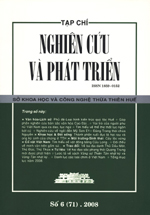Đôi điều về minh văn trên gốm sứ - Phần I: Những điểm chung cần sáng tỏ (Tiếp theo)/About the Inscriptions on Vietnamese Ceramics - Part 1: Some General Need-to-be-Clarrified Issues (Continued)
Tóm tắt
Lần đầu tiên từ xưa tới nay, các tác giả đã xuất phát từ quan điểm nghiên cứu liên ngành và đa ngành, nhìn minh văn theo tính hệ thống lịch sử-địa lý nên đã phân loại minh văn theo nội dung và hình thức trình bày, trong khi sản xuất và sau khi sản xuất (đặc thù của Việt Nam), đã chú ý đến thư pháp và tả tự pháp của minh văn. Từ nghiên cứu hồi cố trong thực tế Việt Nam, các tác giả nhìn một đồ gốm như sản phẩm của một lò gốm chứ không chỉ của một mình người viết minh văn. Khác với nước ngoài, ở Việt Nam chính người thợ gốm viết minh văn; riêng trên những đồ sứ men lam Huế (đồ sứ ký kiểu), có thể các nhà Nho viết minh văn. Các tác giả đề nghị một trình tự công việc để giải thích và đánh giá minh văn, trong đó chú ý đặc biệt đến việc phân biệt giữa khách quan và chủ quan. Nhận thức, quan điểm và nhân cách của người đánh giá ảnh hưởng nhiều đến kết quả.
ABSTRACT
With multi-, inter-disciplinary approach and geo-historical systematic viewpoint, the authors carried out research on the inscription on Vietnamese ceramics. They proposed a classification framework based on the contents and presentation forms of inscription, especially during and after the production process; the last one is specific for Vietnam. The calligarphy and graphology are mobilized to interprete the inscription. The result of reminiscent research on the labor division in familial kilns does permit them to see a ceramic as the product of the whole kiln’s people. Quite different from foreign countries, in Vietnam the inscription was written by the potter himself but on the bleus-de-Huế, the nhà Nho (lettré, literates) probably assumed this step. The authors proposed an interpretation procedure, which insists on the difference between the objectivity and subjectivity and on the judgement on the facts as presented and freedom from any prejudgement. Openness, transparency, and flexibility are needed in this process.

